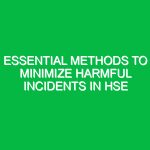Introduction
In the ever-evolving landscape of the Health, Safety, and Environment (HSE) domain, hazard inspections play a pivotal role. These inspections are essential for identifying, assessing, and mitigating risks that could lead to accidents or environmental damage. However, several factors significantly impact the effectiveness of these inspections. Understanding these three critical factors can enhance the Safety culture within organizations and ensure compliance with legal and regulatory Standards.
In this article, we will explore these three factors impacting hazard inspections: organizational culture, training and competence of personnel, and the integration of technology. Each factor has a profound influence on how inspections are conducted, the outcomes they produce, and the overall Safety environment of the workplace.
Organizational Culture
Organizational culture is the foundation upon which safety protocols are built. It encompasses the values, beliefs, and behaviors that shape how safety is perceived and prioritized within an organization. A strong safety culture promotes proactive hazard inspections, while a weak culture can lead to neglect and oversight.
The Importance of Safety Culture
A robust safety culture encourages employees to speak up about potential Hazards without fear of retribution. For instance, in a manufacturing firm that prioritizes safety, employees are trained to identify and report unsafe conditions. This open communication channel fosters a proactive approach to hazard inspections, enabling organizations to address issues before they escalate into serious incidents.
Conversely, in organizations where safety is seen as a checkbox activity, employees may feel discouraged from reporting unsafe practices. This attitude can lead to a culture of silence, where Hazards go unnoticed, ultimately resulting in accidents.
Strategies to Enhance Safety Culture
To promote a positive safety culture, organizations can implement several strategies:
- Leadership Commitment: Leadership must demonstrate a genuine commitment to safety by prioritizing it in strategic planning and daily operations.
- Employee Involvement: Involve employees in the development and implementation of safety policies, ensuring they feel valued and heard.
- Regular Communication: Foster an environment where safety discussions are a regular part of meetings and Training sessions.
- Recognition Programs: Implement programs that recognize and reward safe behavior and proactive reporting of hazards.
By embedding safety into the organizational culture, companies can improve the efficacy of hazard inspections and create a safer work environment.
Training and Competence of Personnel
The second critical factor impacting hazard inspections is the training and competence of personnel involved in the inspection process. A well-trained workforce is essential for identifying hazards accurately and implementing appropriate corrective measures.
Training Programs and Their Impact
Training should be comprehensive, covering not only the technical aspects of hazard identification but also the importance of safety protocols and Regulations. For example, in the construction industry, workers must be trained in recognizing potential Fall Hazards, understanding Personal Protective Equipment (PPE) requirements, and knowing how to conduct safety audits.
Inadequate training can lead to oversights during inspections. Consider a case where a team of inspectors failed to recognize a critical safety hazard due to a lack of understanding of the equipment involved. Such oversights can have severe consequences, including accidents and legal ramifications.
Continuous Professional Development
Moreover, training shouldn’t be a one-time event. Continuous professional development is vital in keeping personnel updated on the latest safety standards, regulations, and technologies. Organizations should encourage ongoing education through workshops, certifications, and refresher courses. This approach not only enhances individual competence but also strengthens the overall inspection process.
Assessment of Competence
To ensure that personnel are adequately trained, organizations can implement competency assessments. These assessments can take various forms, such as practical evaluations during inspections or theoretical tests on safety regulations and protocols. By regularly assessing competence, organizations can identify knowledge gaps and provide additional training where necessary.
Integration of Technology
The third factor impacting hazard inspections is the integration of technology into the inspection process. Technology has revolutionized various aspects of HSE practices, including hazard inspections, making them more efficient and effective.
Utilizing Inspection Software
Inspection software can streamline the process of hazard identification and reporting. For instance, mobile applications allow inspectors to document hazards in real-time, attach photographs, and generate reports instantly. This immediacy ensures that hazards are addressed promptly, reducing the risk of accidents.
Moreover, these software solutions often come equipped with analytics capabilities, enabling organizations to track trends and identify recurring hazards. By analyzing this data, companies can implement targeted interventions that address root causes rather than merely treating symptoms.
Remote Inspections and Drones
Another technological advancement impacting hazard inspections is the use of drones for remote inspections. Drones can access hard-to-reach areas, such as rooftops or high-voltage installations, allowing for thorough inspections without putting personnel at risk. This capability is particularly valuable in industries such as energy and telecommunications, where safety risks are elevated.
Additionally, virtual reality (VR) and augmented reality (AR) technologies are emerging as tools for training personnel in hazard identification. By simulating real-world scenarios, these technologies provide employees with hands-on experience in a controlled environment, enhancing their ability to recognize hazards during actual inspections.
Regulations and Standards
The HSE domain is governed by a myriad of regulations and standards that directly impact hazard inspections. Organizations must comply with these regulations to ensure safety and avoid legal repercussions.
Key Regulations Affecting Hazard Inspections
Some of the key regulations include:
- Occupational Safety and Health Administration (OSHA) Standards: osha provides guidelines that dictate how inspections should be conducted and what Safety Measures must be in place.
- Environmental Protection Agency (EPA) Regulations: The EPA sets standards for Environmental Safety, impacting how inspections are carried out in industries that pose environmental risks.
- ISO Standards: International Organization for Standardization (ISO) standards, such as ISO 45001, outline requirements for Occupational Health and safety management systems.
Compliance with these regulations not only ensures safety but also enhances an organization’s reputation. Companies known for adhering to safety standards are often more attractive to clients and employees alike.
Impact of Regulations on Inspection Processes
Regulations influence various aspects of hazard inspections, from the frequency of inspections to the documentation required. Organizations must stay abreast of changes in regulations to adapt their inspection processes accordingly. Regular audits and reviews of inspection protocols can help ensure compliance and identify areas for improvement.
Conclusion
In conclusion, the three critical factors impacting hazard inspections—organizational culture, training and competence of personnel, and the integration of technology—play a significant role in shaping the safety landscape within various industries. By fostering a positive safety culture, investing in comprehensive training programs, and embracing technological advancements, organizations can enhance the effectiveness of their hazard inspections.
These efforts not only promote a safer workplace but also contribute to environmental Sustainability and compliance with regulatory standards. As industries continue to evolve, it is imperative for organizations to remain vigilant and proactive in their hazard inspection practices. By doing so, they can mitigate risks, protect their workforce, and ultimately cultivate a safer future for all.
Engaging in ongoing discussions about safety practices and seeking innovative solutions can pave the way for continuous improvement in hazard inspections, ensuring that safety remains at the forefront of organizational priorities.


